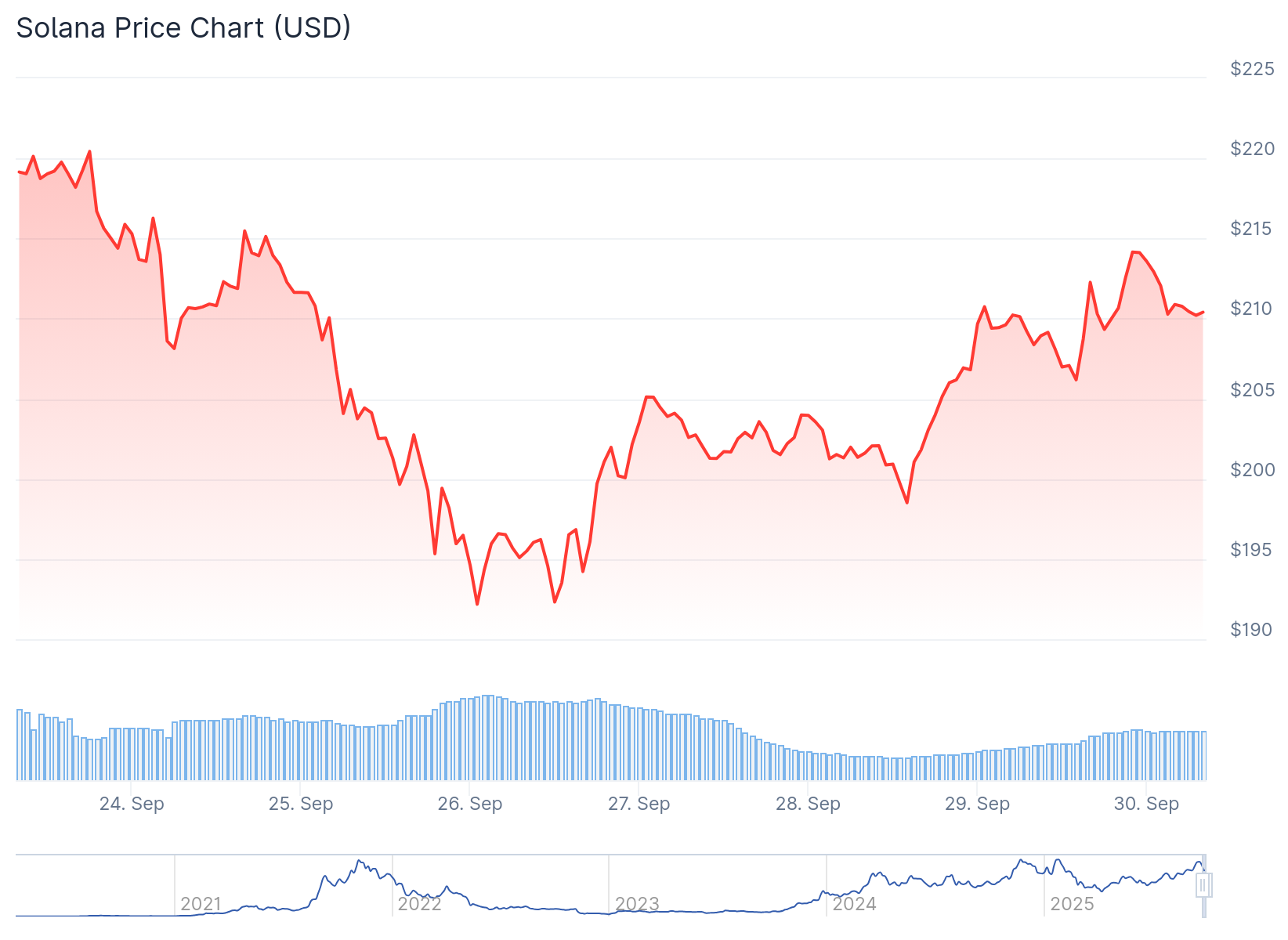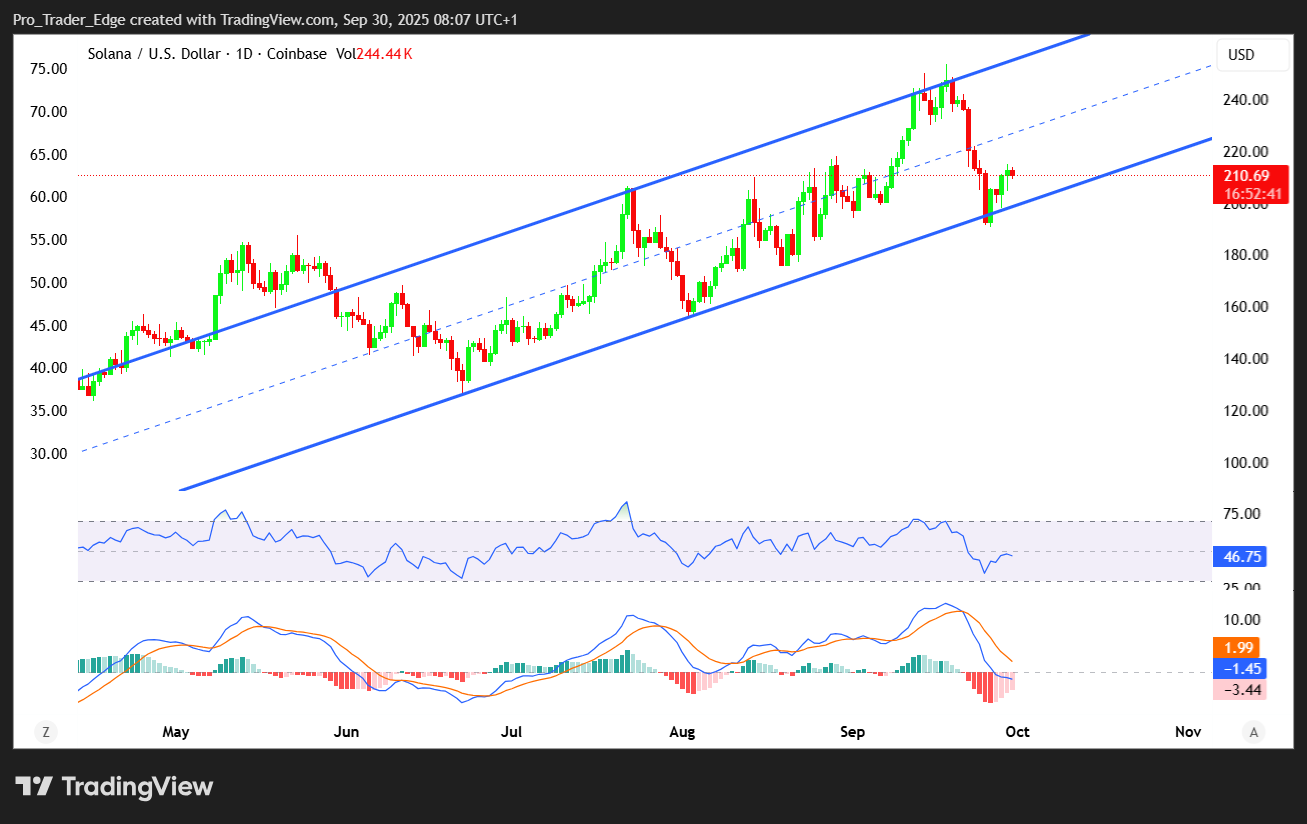TLDR
- Solana price rebounded 10.5% from $191 to $210 but trails Ethereum and BNB over two-week period
- Network transactions dropped 10% and fees fell 50% as Hyperliquid, Aster, and edgeX capture market share
- SEC spot ETF decision deadline set for October 10 with 95% approval probability according to analysts
- Firedancer proposal SIMD-0370 would eliminate fixed compute limits and boost network throughput
- Forward Industries controls 1.58 billion SOL tokens, over 5% of circulating supply
Solana price recovered over the weekend after testing support at $191 on Friday. The token climbed 10.5% to reach $210 levels.

The rebound comes as President Trump indicated he would work to prevent a government shutdown. Congress still needs 60 votes to pass temporary funding legislation by Tuesday.
Gold hit an all-time high of $3,833 on Monday, reflecting investor concerns about US fiscal debt. The Treasury pays over $1 trillion annually in interest expenses.
Despite the recovery, SOL has underperformed competitors over the past two weeks. The token remains down 10% while Ethereum and BNB posted stronger gains.
Network Activity Declines
Solana network metrics show declining user engagement. Transactions fell 10% over the past seven days while network fees dropped nearly 50%, according to Nansen data.
Competing blockchains showed opposite trends. BNB Chain fees increased 56% during the same period. Arbitrum and HyperEVM more than doubled their fee revenue week over week.
The rise of alternative perpetual futures platforms has impacted Solana’s market position. Hyperliquid launched its own blockchain to reduce fees and eliminate validator maximal extractable value.
Aster, backed by YZi Labs (formerly Binance Labs), currently runs on BNB Chain but plans to launch an independent layer-1 network. These platforms compete with Solana’s Meteora, Raydium, and Pump exchanges.
Firedancer Upgrade Could Boost Performance
Jump Crypto’s Firedancer team introduced proposal SIMD-0370 to remove Solana’s fixed compute unit limits. Currently, each block operates under a 60 million compute unit cap regardless of validator hardware capabilities.
The upgrade would let validators skip blocks they cannot process in time. This creates performance incentives where block producers earn higher fees while validators that skip blocks lose rewards.
The proposal aims to create a performance flywheel effect. Stronger validators would enable higher network throughput as the baseline capacity increases across the ecosystem.
Some experts expressed concerns about potential centralization risks. Roger Wattenhoffer, head of research at Anza, noted the upgrade could introduce technical challenges but suggested solutions exist.
ETF Approval Could Drive Price Higher
The Securities and Exchange Commission faces an October 10 deadline for Solana spot ETF applications. Market analysts assign 95% or higher probability to approval.

A successful ETF launch could bring institutional capital inflows. Forward Industries, the largest Solana digital treasury, has accumulated over 1.58 billion SOL tokens.
Questions remain about validator sustainability. Analysis shows 76% of validator income derives from newly issued tokens rather than transaction fees or maximal extractable value.
This dependency on token inflation raises concerns given Solana’s nearly 1,000 validators and their operational costs. Critics suggest this could impact long-term staking reward rates.
Solana price currently holds above $200 support levels. Technical indicators show mixed signals with RSI above 45 while MACD remains bearish. Bulls target the $230 to $255 range if support holds.



